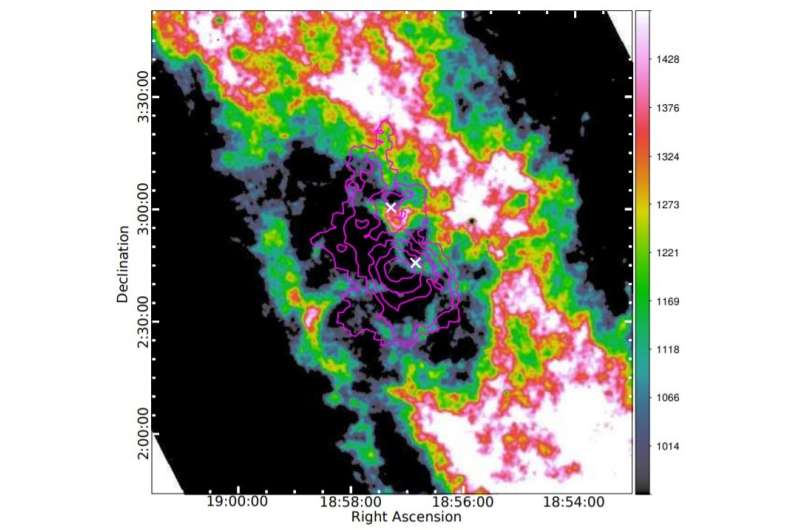HI distribution towards HESS J1856+026. Credit: Petriella et al., 2021.
Argentinian astronomers have conducted radio observations of a very-high-energy gamma-ray source known as HESS J1857+026. Results of this study provide new insights into the nature of this mysterious source. The research was detailed in a paper published July 27 on the arXiv pre-print server.
Sources emitting gamma radiation with photon energies between 100 GeV and 100 TeV are called very-high-energy (VHE) gamma-ray sources. Observations show that these sources are often blazars or binary star systems containing a compact object. However, the nature of many VHE gamma-ray sources is still not well understood.
At a distance of some 20,500 light years, HESS J1857+026 is an extended VHE gamma-ray source harboring Vela-like radio pulsar located about 8′ offset from the centroid of the gamma-ray emission. The pulsar, designated PSR J1856+0245, has a spin period of 81 milliseconds, a spin-down age of 21,000 years and a spin-down energy at a level of 4.6 undecillion erg/s.
The true nature of HESS J1857+026 remains unclear. One study suggested that it could be a pulsar wind nebula (PWN) powered by PSR J1856+0245. Another hypothesis is a two-source model for HESS J1857+026, in which the gamma-ray appearance is produced by the superposition in the line of sight of two unrelated sources located at two different distances.
A team of researchers led by Alberto Petriella of the University of Buenos Aires decided to conduct radio continuum observations of HESS J1857+026 using the Karl G. Jansky Very Large Array (VLA). The main goal of the observational campaign was to shed more light on the mysterious nature of this source.
The astronomers found no evidence, down to the noise level of the VLA radio images, of enhanced emission associated with HESS J1857+026 or PSR J1856+0245. If detected, such emission could represent a probable PWN.
The study detected a neutral hydrogen (HI) superbubble in the direction toward HESS J1857+026 in the velocity range between 81 and 100 km/s. The data suggest that this structure is located at a distance of about 18,000 light years away, which is compatible (within the errors) with the distance to the pulsar PSR J1856+0245.
The finding allowed the astronomers to conclude that the emission from HESS J1857+026 originates in a superbubble. This favors a single gamma-ray source scenario rather than the superposition of two distinct sources.
"The TeV emission appears completely immersed within the HI cavity and both of them present elongated shapes in the direction parallel to the Galactic plane. The spatial and morphological match between the SB [superbubble] and the entire TeV emission from HESS J1857+026 suggests an association between them, arguing in favour of a single gamma-ray source confined inside the HI cavity and located at a distance of ∼ 5.5 kpc," the authors of the paper concluded.
More information: Alberto Petriella et al, Radio study of HESS J1857+026. Gamma-rays from a superbubble?, arXiv:2107.12849 [astro-ph.HE] arxiv.org/abs/2107.12849
© 2021 Science X Network
























